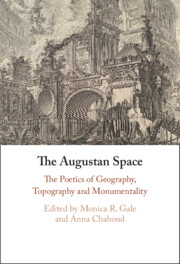Book contents
- The Augustan Space
- The Augustan Space
- Copyright page
- Contents
- Notes on Contributors
- Preface
- Abbreviations
- Introduction
- Chapter 1 The City in Horace’s sermo
- Chapter 2 excucurristi a Neapoli
- Chapter 3 Poetic and Imperial Spaces in Propertius, Books 1–3
- Chapter 4 Horace on Sacred Space
- Chapter 5 Roman Topography, Politics and Gender
- Chapter 6 aurea nunc, olim siluestribus horrida dumis
- Chapter 7 Hippolytus and Egeria in the Woods of Aricia (Virgil, Aen. 7.761–82 and Ovid, Met. 15.479–551)
- Chapter 8 locum tua tempora poscunt
- Chapter 9 imperii Roma deumque locus
- Chapter 10 The Rise and Fall of Virgil’s Sublime Carthage
- Chapter 11 Eccentric Poetry
- Chapter 12 Virgilian Heterotopias
- Chapter 13 loci desperati
- Works Cited
- Index Locorum
- General Index
Chapter 9 - imperii Roma deumque locus
Rome as Celestial City
Published online by Cambridge University Press: 14 June 2024
- The Augustan Space
- The Augustan Space
- Copyright page
- Contents
- Notes on Contributors
- Preface
- Abbreviations
- Introduction
- Chapter 1 The City in Horace’s sermo
- Chapter 2 excucurristi a Neapoli
- Chapter 3 Poetic and Imperial Spaces in Propertius, Books 1–3
- Chapter 4 Horace on Sacred Space
- Chapter 5 Roman Topography, Politics and Gender
- Chapter 6 aurea nunc, olim siluestribus horrida dumis
- Chapter 7 Hippolytus and Egeria in the Woods of Aricia (Virgil, Aen. 7.761–82 and Ovid, Met. 15.479–551)
- Chapter 8 locum tua tempora poscunt
- Chapter 9 imperii Roma deumque locus
- Chapter 10 The Rise and Fall of Virgil’s Sublime Carthage
- Chapter 11 Eccentric Poetry
- Chapter 12 Virgilian Heterotopias
- Chapter 13 loci desperati
- Works Cited
- Index Locorum
- General Index
Summary
In a famous passage of his Metamorphoses Ovid describes the via Lactea, leading from Earth to Heaven and to the Gods of Olympus, by comparing it to the city of Rome (1.173–6). But if Heaven is like Rome, Rome too is like Heaven: in his exile poetry Ovid represents the emperor as ‘Jupiter on earth’, and it is an obvious consequence that the places inhabited by him may appear as a sort of Olympus on earth. Augustus’ house is thus described as Jupiter’s royal palace (Tr. 3.1.33–8 uideo fulgentibus armis | conspicuos postes tectaque digna deo, | et ‘Iouis haec’ dixi ‘domus est?’ quod ut esse putarem, | augurium menti querna corona dabat. | cuius ut accepi dominum, ‘non fallimur’, inquam, | ‘et magni uerum est hanc Iouis esse domum’), and this reversal of the normal spatial hierarchy becomes a standard encomiastic/panegyric trait of the Imperial age (cf. Statius’ description of Domitian’s house at Silv. 4.2.18–21, and many of Martial’s references to Domitian’s courtly world). Rome, being the seat of imperial power, thus looks like a heavenly city: a paradoxical anticipation of (or maybe a hint of?) the Christian idea that will be elaborated by Augustine.
Keywords
- Type
- Chapter
- Information
- The Augustan SpaceThe Poetics of Geography, Topography and Monumentality, pp. 146 - 163Publisher: Cambridge University PressPrint publication year: 2024

